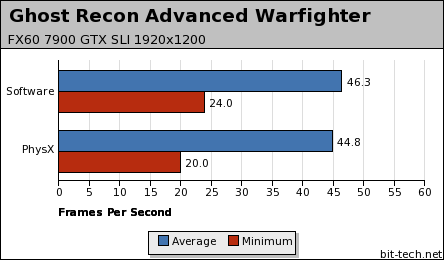Benchmarks
There have been persistant rumours on the net that the extra eye candy generated when running a PhysX-enabled system would cause a drop in frames per second. As the theory goes, there is extra geometry flying around the screen that wasn't there before that has to be drawn, causing extra GPU load. Many users were expecting the opposite - a speed increase - by offloading physics calculations from the CPU to PPU but those hopes were scotched when we met with AGEIA at the Games Developers Conference:"We drive sales of high-end hardware," Andy Hess, Director of Content Acquistion for AGEIA told us. "When you have a PhysX processor in your system, you've gotta have that SLI. You've gotta have both graphics cards to handle the amount of data that we send out. We keep those guys really busy."
To test this theory, we put together two systems: a super-top-of-the-range system, and a more modest gaming rig. We played through the first three checkpoints on the Coup d'état, representing four full minutes of action. The first ten seconds were used to test the special effects - we emptied a full clip into a nearby tree, and grenaded a car. The remainder of the play time was used to play the game just as anyone would normally.
High End System Setup:
AMD Athlon 64 FX-60 (operating at 2600MHz, 13x200MHz), ABIT AN8 32X (NVIDIA nForce4 SLI X16); 2 x 1GB Corsair XMS4000 Pro (operating in dual channel at 400MHz with 2.0-3-3-7-1T timings); Seagate Barracuda 7200.9 200GB 7,200RPM SATA II hard disk drive; OCZ PowerStream 600W power supply unit; Windows XP Professional Service Pack 2; DirectX 9.0c; NVIDIA nForce4 SLI X16 platform drivers, version 6.82; AGEIA PhysX drivers version 2.4.3
2 x BFG Tech GeForce 7900 GTX OC 512MB - operating in SLI at their default clock speeds of 670/1640MHz using Forceware 84.43, available from nZone. "Coolbits" was enabled in the registry using Option 8, and Alternate Frame Rendering (AFR) was selected.
We recorded frame rates with and without the BFG Tech AGEIA PhysX Physics Processing Unit installed in our system.

Mid-Range System Setup:
AMD Athlon 64 3700+ (operating at 2200MHz, 11x200MHz); ABIT AN8 32X (NVIDIA nForce4 SLI X16); 2 x 512MB Corsair XMS3200XL Pro (operating in dual channel at 400MHz with 2.0-3-3-7-1T timings); Seagate Barracuda 7200.9 200GB 7,200RPM SATA II hard disk drive; OCZ PowerStream 600W power supply unit; Windows XP Professional Service Pack 2; DirectX 9.0c; NVIDIA nForce4 SLI X16 platform drivers, version 6.82; AGEIA PhysX drivers version 2.4.3
HIS Radeon X850XT IceQ II iTurbo 256MB - operating at its default clock speeds of 520/1080MHz using Catalyst 6.4 WHQL.
Again, we recorded frame rates with and without the BFG Tech AGEIA PhysX Physics Processing Unit installed in our chosen system.

The performance hit from enabling the PPU effects is noticable: 13% on average and over 26% on the minimum, costing 6 full frames per second and crucially dropping the minimum into the teens. While it's less likely that someone with such a relatively modest system spec (for gaming in 2006, that is) would spend the cash on a PPU card, it does appear that in GRAW they are better off without it.

MSI MPG Velox 100R Chassis Review
October 14 2021 | 15:04









Want to comment? Please log in.